Projects of survival

'Blue Shift [LOG. 1]' is a Darwinian installation piece that was realized together with evolutionary biologist Prof. Luc De Meester from the University of Leuven (Belgium) and engineers from electronics company Philips (Turnhout, Belgium).
'Blue Shift [LOG. 1]' is a Darwinian installation piece that was realized together with evolutionary biologist Prof. Luc De Meester from the University of Leuven (Belgium) and engineers from electronics company Philips (Turnhout, Belgium).
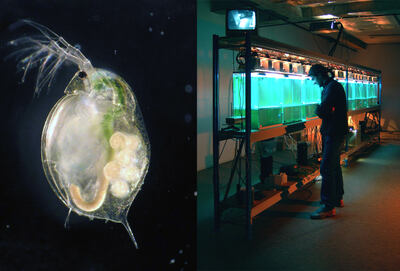
'Blue Shift [LOG. 1]' is a Darwinian installation piece that was realized together with evolutionary biologist Prof. Luc De Meester from the University of Leuven (Belgium) and engineers from electronics company Philips (Turnhout, Belgium). It is an interactive installation with a living model ecosystem at its core. Using single-cell algae, water fleas, fish and water snails, a compact aquatic community is set up in the exhibition space. The whole system is designed in such a way that visitors drastically induce a gradual microevolution of the – genetically determined – light-responsive behavior of the water fleas. When the system is in standby, yellow lights illuminate the aquariums from the top. The water fleas are strongly attracted to this light and swim in close proximity to it, near the surface of the water. Whenever a visitor approaches the installation and passes a wall-mounted sensor, blue spotlights on the top of the aquariums are activated. The water fleas are repelled by this color of light, flee downwards and pass through holes in a false bottom in the aquariums. However, fish are residing in the lower sections of the aquariums and most of the water fleas are immediately wiped out.
What can be considered to be a survival strategy in natural circumstances – blue light indicates clear open water and hence potential detection by fish – has quite a different meaning in this set-up: it is exactly those water fleas that do not swim away from the blue light that survive and reproduce. In this way their genes will become dominant in the water flea populations and a 'contra-natural' selection will occur. The installation aims to question the status of the utilitarian in art and science, and push interactive installation art into Darwinian realms.
'First Room for MELiSSA' is a poetic preview of Space Ecologies (working title), an artistic research project dealing with habitat and space exploration. This multi-layered installation revolves around the urge for survival and procreation, confinement, design, personal affection, and the archetypal human fear of annihilation. For this exhibition, Vermeulen and Holvoet designed conceptual narratives linked to the European Space Agency’s MELiSSA project. Based on the concept of an artificial ecosystem, MELiSSA, short for Micro-Ecological Life Support System Alternative, is the European model for a regenerative life support system for astronauts. MELiSSA allows the production of oxygen, water and food, and the recycling of organic wastes and carbon dioxide. Such regenerative life support systems will enable future long-term manned space missions such as a lunar base or a mission to Mars by ensuring crew survival.
An architectural integration with hibernation sculptures, dropped ceilings, text and graphics, and two sole green plants refers to space-based ecosystems, and to a general human and personal desire to live and work in space for extended periods longer than 14 months – the longest period any astronaut has spent in space until this date. Graphic designer Raf Vancampenhoudt created the layout of the text panels. Two ceramic 'pillows' by artist An Van den Abbeele were integrated in the hibernation sculptures.
An artist residency at the House of Natural Fiber (HONF) in Yogyakarta (Indonesia) has been scheduled for July and August 2011. This residency will be entirely integrated into the Space Ecologies platform. The activities will focus on exploring traditional Indonesian cosmologies, and on 'terraforming' the nearby Mount Merapi volcano. Last year a series of intense eruptions of Mount Merapi wiped out a large area now covered with lava and volcanic ash. Social and biological life has been decimated, and all that remains is black soil with protruding burned trees. It is estimated are that over 300.000 people were displaced in October and November 2010. As of December 2010 the Centre for Volcanology and Geological Hazard Mitigation lowered the status of Mount Merapi to the level of ‘Caution Alert’ (Level III). With this alert level the potential of hot ash clouds and projected incandescent material still remains.
Contrary to popular belief, volcanic material of Mount Merapi is not a good substrate for growing plants since it does not contain nitrogen, one of the key elements for plant metabolism. Since it contains many other minerals, it can be used as a supplmentary fertilizer on regular soil. But the lack of nitrogen remains a key problem for plant restoration. During the artist residency, a biological sculpture will be created on the slopes of Mount Merapi. The art piece will function as a framework for experimentation in permaculture and local food cultivation. By using nitrogen-fxing bacteria the volcanic soil can be ‘terraformed’ and become hospitable to plants. Rhizobium bacteria live in symbiosis with the roots of legume plants. These legumes can then function as pioneering organisms setting the stage for other plants to grow and thrive. The biological sculpture will also function as a beacon, a monument in the scarred landscape. Its is conceived as a symbol of life and as a reminder to the trauma the volcano has been engendering. The whole project will be carried out in collaboration with local communities, both from Mount Merapi and from Yogyakarta. Prof. Irfan D. Prijambada of Gadjah Mada University will provide scientific support for the microbiological aspects of the project. In March 2010 a preparatory field trip was carried out in the region.
Dynamics and self-organization
Creating frameworks where things can happen, beyond expectations, beyond control.
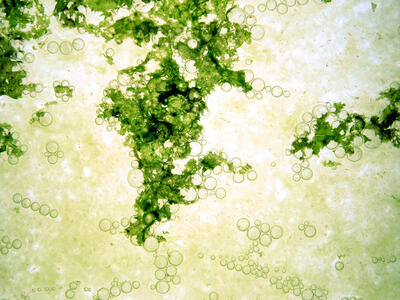
This is a call for evolution, for progress. But not in a Modernist sense – linear, universal, imposing. It's about embracing the very nature of things: flux, disruption and reconfiguration. It's about creating frameworks where things can happen, beyond expectation, beyond control. 'Framework' is essential here, indicating the human need for a base level of initiative or control. This is where human creativity comes in first. But then letting go and allowing change, that's the crucial artistic challenge. Allowing processes to migrate and redefine their boundaries, while building faith in their self-organizing capacity.
"All good thoughts and all good works of art run on their own as a perpetual motion machine, mentally and sometimes physically; they are very alive" – Jason Rhoades, 'Perfect World'
Violence as natural principle

"You can also take a positive view of violence and regard it as a kind of life energy, a driving force behind self-transcendence." – Antoon Van den Braembussche
"You can also take a positive view of violence and regard it as a kind of life energy, a driving force behind self-transcendence." – Antoon Van den Braembussche
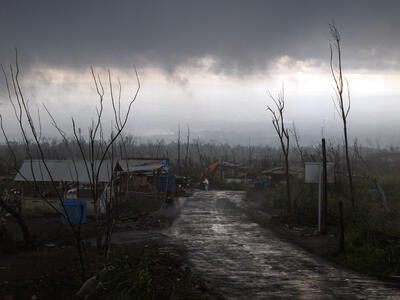
Angelo Vermeulen: There’s violence at all levels of an ecosystem all the time. If you think of violence in nature, one of the first things that crosses your mind is the classical example of predation: the lioness going for the throat of the innocent antelope. People often say that you cannot compare this violence with human violence, because animals kill only to satisfy their basic needs. But chimps also raid and rape, forming gangs to attack neighboring colonies, kill the males, and rape and abduct the females. That is downright warfare among animals to expand their territory and spread their genes. Plants – traditionally the epitome of peace to us human beings – also compete in violent ways. Just look at what happens when an old tree in the rain forest falls over, leaving an open area. All manner of plants and trees immediately enter into fierce competition for the new space and light.
Antoon Van den Braembussche: Again, you can also take a positive view of violence and regard it as a kind of life energy, a driving force behind self-transcendence. If you allow me to give my point of view as a philosopher, I’d say that violence – also ontologically – as a way of being, fulfils a highly creative and life-contributing function. This is very much present in Nietzsche’s works. Nietzsche’s vision strongly emphasizes the ‘affirmation of life’. This is reflected, for instance, in his amor fati, the love of fate, acting against the odds. To Nietzsche, life is always characterized by more life, which is also underlined by his – often greatly misunderstood – notions of Übermensch (superman) and Wille zur Macht (will to power). The will to power refers not only to life-preservation itself but to the preservation of life in the sense of continuous self-transcendence. In the context of this conversation it should be noted that Nietzsche was criticized for his more or less biologist and Darwinist thinking.
– Excerpt from 'Violence, Transgression and Modernity' published in 'Baudelaire in Cyberspace: Dialogues on Art, Science and Digital Culture', Antoon Van den Braembussche & Angelo Vermeulen, 2008
Projects like 'Blue Shift [LOG. 1]', 'First Room for MELiSSA', and the residency project at Mount Merapi offer people a possibility to relate to the fundamental issues of violence and survival. Sometimes it actually forces them to take position. It's hard to witness predation in 'Blue Shift [LOG. 1]' without taking any ethical stance. After all, it's precisely through your own physical presence that the art work carries out its logic and eliminates its living agents. The project on Mount Merapi is like the inverse of this. In a place of total devastation, life is brought back through art - on both a physical and mental level. Here, the participants and spectators generate life through their own involvement.
Failure and survival

Nature and technology are our means to re-structure the tangible world. 'Nature' is understood here as an expanded concept beyond 'the pristine'. It's the totality of (rare) primary nature and human-engendered nature. Our world is a hybrid world.
Nature and technology are our means to re-structure the tangible world. 'Nature' is understood here as an expanded concept beyond 'the pristine'. It's the totality of (rare) primary nature and human-engendered nature. Our world is a hybrid world.
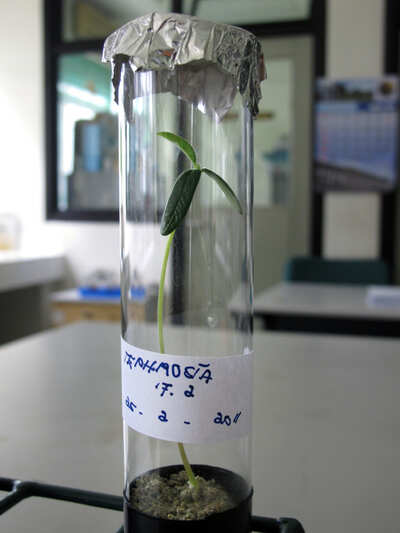
Every single moment, things could take a different turn, or simply fail. This is not a pessimistic world view. It's simply an acknowledgement that most things are the way they are, because we choose them to be like that – and not because the world is inherently structured as such. This opens up possibilities and fundamentally engenders freedom. It's an empowerment of the mind, and of our physical relation to the world.
Nature and technology are our means to re-structure the tangible world. 'Nature' is understood here as an expanded concept beyond the pristine. It's the totality of human-engendered nature and (rare) primary nature. Our world is a hybrid world.
The (historical) colonist is the archetype of man having to negotiate with new nature. A survival process in which both will irrevocably transform each other. The question is not, should we colonize; after all, migration, colonization and hybridization is what makes us human. The question is, how to ethically colonize, and ultimately how to survive.
Synopsis

Biomodd is a collaborative art project conceived to challenge presumed notions of opposition between nature and technology in different cultures throughout the world.
Biomodd is a collaborative art project conceived to challenge presumed notions of opposition between nature and technology in different cultures throughout the world.
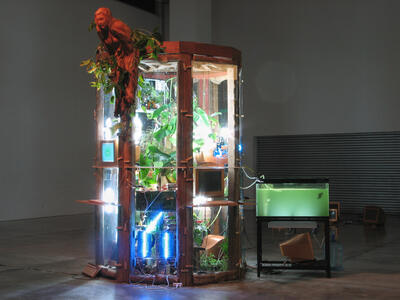
Biomodd is a collaborative art project conceived to challenge presumed notions of opposition between nature and technology in different cultures throughout the world. The project started in 2007 during a residency of Angelo Vermeulen at The Aesthetic Technologies Lab in Athens, Ohio. Since then multiple versions have been built both by the people that originally came up with the idea, and by other communities throughout the world. Up till now, Biomodd art works have been created and showcased in Athens (Ohio), Los Banos (Philippines), Manila (Philippines), Cavite (Philippines), Sint-Niklaas (Belgium) and Maribor (Slovenia). In 2011 more will follow in New Zealand and the Netherlands. Biomodd is an open source art work and can be built and improved upon by anyone.
Since 2010 there's a new format for the Biomodd project: apart from building complex large-scale versions, there's also Biomodd Workshops in which people learn the basics of green case modding in a period of one to two weeks. Participants are led through an improvisatory process of creating functioning hybrid biological and digital sculptural forms that are consonant with the Biomodd conceptual framework, though on a smaller scale than the installations produced in Biomodd [ATH1] and Biomodd [LBA2]. Participants are introduced to the Biomodd conceptual framework and experiences from previous Biomodd workshops and projects. We show previous examples of systems that participants have built that integrate plant life and computer technology. We provide the participants with materials both taken locally and used in previous Biomodd workshops and projects.
Biomodd is predicated on a set of themes that are briefly introduced below. These themes have been defined and adjusted over the course of several years. Especially Philippine Biomodd Co-lead Diego Maranan was instrumental in giving this list its current outlook.
[1] Symbiosis between biology and technology

In Biomodd, nature and technology are not juxtaposed but rather fused into imaginative hybrid installations.
In Biomodd, nature and technology are not juxtaposed but rather fused into imaginative hybrid installations.
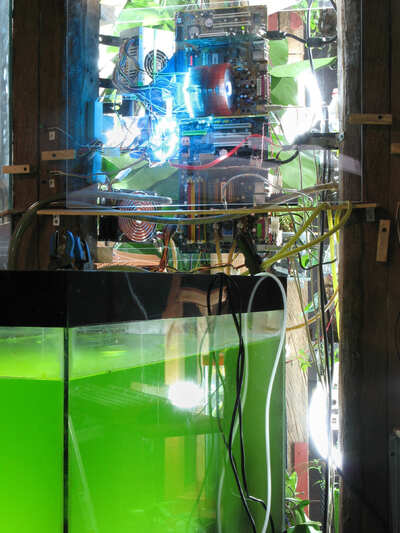
In Biomodd, nature and technology are not juxtaposed but rather fused into imaginative hybrid installations. The core idea is the creation of experimental systems in which modified computer networks coexist with living ecosystems. The challenge is to bring biological life as physically close to the electronics as possible, and allow them to communicate with each other through meaningful symbiotic relationships.
[2] E-waste and its creative reuse
Electronic waste is one of the most problematic consequences of digital technology.
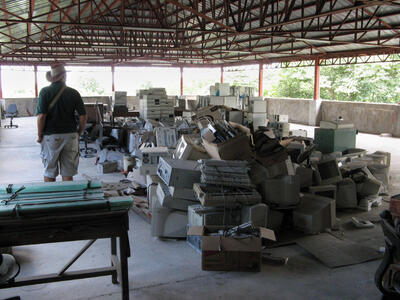
Electronic waste is one of the most problematic consequences of digital technology. In addition to conventional e-waste recycling, reusing old hardware for art projects provides another mechanism for dealing with the growing problem of e-waste. In addition, after showcasing the result each hybrid installation is fully disassembled, and its components are re-used and recycled. Biological life is adopted by collaborators or taken back to nature.
[3] Case modding

The idea of case modding is approached as a form of expanded sculpture. In this sculptural approach a 'functional' form factor is not imperative; rather, it's about building a structure that is both sculpture and a functioning computer.
The idea of case modding is approached as a form of expanded sculpture. In this sculptural approach a 'functional' form factor is not imperative; rather, it's about building a structure that is both sculpture and a functioning computer.
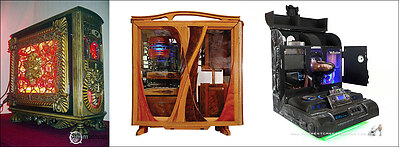
Biomodd's name derives in part from the practice of case modding, a primary inspiration of Biomodd. The case modding scene is a very active and creative subculture, something that operates way beyond the boundaries of contemporary art. In Biomodd such subcultures are explored from an artistic point of view; the project is inspired by the codes and methods that make up such cultural practices. The idea of case modding is approached as a form of expanded sculpture. In this sculptural approach a 'functional' form factor is not imperative; rather, it's about building a structure that is both sculpture and a functioning computer. In Biomodd, the functionality of the computer is co-opted by recycling the heat it emits by building an ecosystem inside the structure living along with the electronics.
[4] Digital games and game culture
Biomodd highlights the social nature of gaming and game culture.
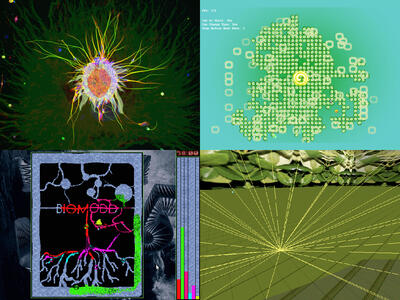
Biomodd highlights the social nature of gaming and game culture. Each installation can function as a station for a fully working multiplayer game. The games are existing open source games that are modified according to the themes of the project, or new experimental games created by the team. Essentially, Biomodd functions as a sculpture that mediates encounters, both on a physical and virtual level.
[5] Collaboration and co-creation

We work with teams and every individual within the group is empowered to add something substantial to the work. This is why the project begins with a solely conceptual focus, and grows organically from there.
We work with teams and every individual within the group is empowered to add something substantial to the work. This is why the project begins with a solely conceptual focus, and grows organically from there.
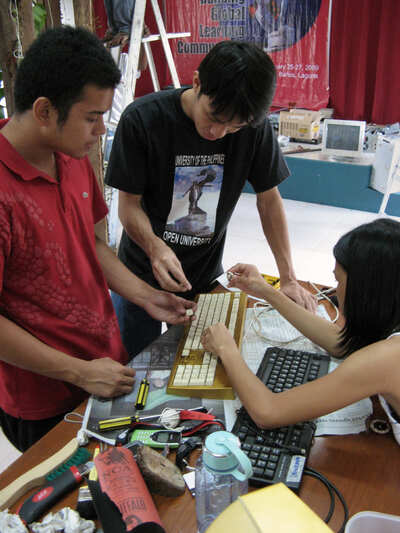
The design of each Biomodd installation is achieved through the exchange of ideas between all participants. Biomodd is explicitly a collaborative effort. This collaborative nature is situated on two levels. On a first level we work with teams and every individual within the group is empowered to add something substantial to the work. This is why the project begins with a solely conceptual focus, and grows organically from there. On a second level the work is recreated in different places throughout the world, each time with different people.
[6] Juxtaposing the local and the global

Each Biomodd version reflects the cultural and social conditions in which it was created and is a reinterpretation of the original concept.
Each Biomodd version reflects the cultural and social conditions in which it was created and is a reinterpretation of the original concept.
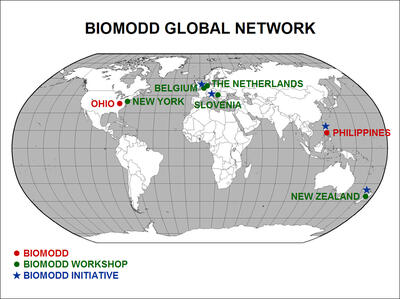
Biomodd is a nomadic art project in which subsequent versions are built with different collaborators and new materials. Each version reflects the cultural and social conditions in which it was created and is a reinterpretation of the original concept. However, selected parts of previous versions are always integrated into each new installation. In this way all versions are conceptually and physically connected, independent of time or location.
[7] Open sourcing

The Biomodd project itself has also taken an open source nature. For instance, instructions for creating your own Biomodd art work are available on the community site.
The Biomodd project itself has also taken an open source nature. For instance, instructions for creating your own Biomodd art work are available on the community site.
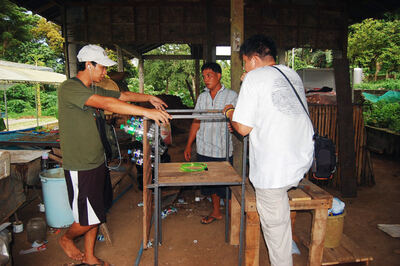
We encourage the use of open source operating system (Linux) and open source game software in order to extend the modification possibilities for the art work as far as possible. The Biomodd project itself has also taken an open source nature. For instance, instructions for creating your own Biomodd are available on the community site. New iterations of Biomodd have been led by other individuals, such as the [M]Biomodd, the version built for the 2009 Youth for IT conference created by students of UPOU, and the [C]Biomodd, led by Al-Francis Librero.
Background

The Biomodd Workshop Sint-Niklaas was organized in the context of Coup de Ville in Sint-Niklaas (Belgium). Coup de Ville was an exhibition and city festival of contemporary art lasting from September to the end of October 2010, and was held in private and public locations in the city-centre of Sint-Niklaas. Key notions were integrity-led artistic engagement, dialogue, superseding cultures and generations. The title symbolically refers to an 'occupied city'.
The Biomodd Workshop Sint-Niklaas was organized in the context of Coup de Ville in Sint-Niklaas (Belgium). Coup de Ville was an exhibition and city festival of contemporary art lasting from September to the end of October 2010, and was held in private and public locations in the city-centre of Sint-Niklaas. Key notions were integrity-led artistic engagement, dialogue, superseding cultures and generations. The title symbolically refers to an 'occupied city'.
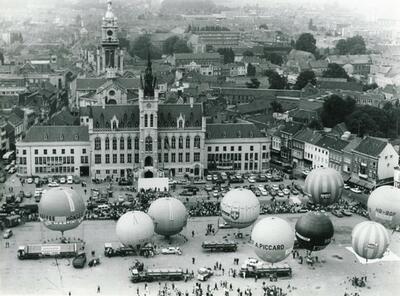
As a location for the workshop the municipal library was chosen. Its industrial basement offered an interesting context to build a technologically-mediated art work buried underneath an immense archive of knowledge. The library management was very interested to set up a social art project since it would generate an additional flow-through of people. It also would expand the image of the library beyond mere passive storage.
Workshop participants

Twelve participants collaborated in this Biomodd Workshop. Most of these came from the Sint-Niklaas area. Two participants, Pieter and Theo, came from other cities in Belgium, respectively Ghent and Antwerp. Eisa came from the Philippines. She participated in the Philippine Biomodd [LBA2] project in 2009, and was an invited artist for the Coup de Ville arts festival. The festival curator explicitly invited her to also participate in the workshop so she could share some of her past Biomodd experience to the group.
Twelve participants collaborated in this Biomodd Workshop. Most of these came from the Sint-Niklaas area. Two participants, Pieter and Theo, came from other cities in Belgium, respectively Ghent and Antwerp. Eisa came from the Philippines. She participated in the Philippine Biomodd [LBA2] project in 2009, and was an invited artist for the Coup de Ville arts festival. The festival curator explicitly invited her to also participate in the workshop so she could share some of her past Biomodd experience to the group.
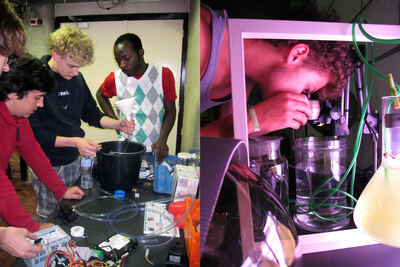
A preceding publication about the workshop in the Belgian popular science magazine Eos was cited by many as the main reason they joined the project. Some of the youngest participants were informed about the workshop by one of their school teachers, a visual artist also participating in Coup de Ville. Up to now, this has been the youngest Biomodd team so far with 8 persons under 20. There were 3 female, and 9 male participants. Almost all participants had no previous experience with building computers. Many of them only had a very basic knowledge about computers which mostly dealt with standard software such as word processing, Internet browsers, and social media. Many had no experience with growing plants or experimenting with biology. Overall there was a high level of participation: 11 out of 12 stayed throughout the whole 6-day workshop, and 7 were strongly involved with the follow-up and exhibition during the two subsequent months (September and October 2010).
Hacking closed-system consumerism

One of the main goals of Biomodd is empowering people to take control over consumer electronics. Biomodd shows people how to open up computers – still an unknown 'black box' for most – and shows them how to creatively assemble a functioning system with used components.
One of the main goals of Biomodd is empowering people to take control over consumer electronics. Biomodd shows people how to open up computers – still an unknown 'black box' for most – and shows them how to creatively assemble a functioning system with used components.
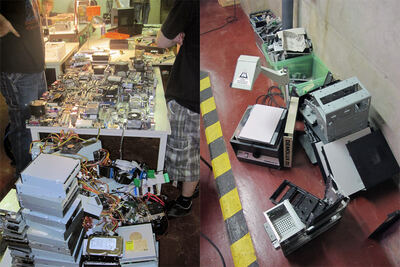
It’s the interchangeability of PC computer components that allows for this. Parts of computers from different brands (and different ages) can be easily connected and recombined into functional workstations. Moreover, the ubiquitous rectangular computer case is not strictly needed to build a computer. Parts can be assembled onto whatever structure available – allowing for a wide range of creative structures. Essentially, these ideas come from both the case modding and hacking scene. In case modding, computer cases are transformed into elaborately decorated pieces. It is a dynamic subculture with active Internet forums, international contests, and specialized hardware such as intricate heat sinks and colourful cold cathode lighting. The hacking scene has traditionally been interested both in software and hardware hacking. Most new digital consumer goods get hacked in a matter of days after their release, after which instructions are posted online. Famous examples are the 'jailbreaking' of the iPhone, and hacking of the Kinect motion sensor. Apart from technically taking apart computers, Biomodd participants are explicitly invited to explore the 'sculptural' potential of electronics, and to find original ways to build computers. This includes the incorporation of living organisms in systems in which electronics and biology co-exist, another core concept of Biomodd.
Before the start of the Biomodd Workshop in Sint-Niklaas, a good amount of used equipment was collected: about 20 computers, 10 monitors, and different peripherals such as network switches and printers. The materials were donated by local schools and computer shops in Sint-Niklaas, a computer refurbishing company in Antwerp (PUC), and the municipal library where the workshop was held. The participants took apart all computers in one single morning session during the first workshop day. I had expected this to take at least one full day, but people were extremely motivated to put their hands on the computers. They eagerly opened up case after case to carefully unscrew and remove all individual components. Whenever somebody got stuck, one of the other participants would spontaneously come over and help out. Theo, a computer refurbishing professional even admitted that he learned about taking apart HP computers. He had been struggling in his company before with opening up a specific type of HP computer case. During the workshop he noticed that one of the teenage participants explored the case for about 15 minutes and then simply figured it out. Theo went over and got a detailed explanation on how to do it.
At the end of this session, everything was sorted: motherboards, hard drives, optical drives, memory modules, power supply units, etc. The fact that all components were pooled together in one central supply gave the group a sense of shared purpose. After some time, it simply became impossible to tell which individual component had been taken out by who. All waste was sorted separately: metal scrap, plastic parts, and dysfunctional electronics. Some of the metal and plastic was used afterwards as construction material. All of recovered components and waste became an integral part of the Biomodd installation during the Coup de Ville arts festival. At the end of the exhibition, materials were adopted by participants or transferred to a local recycling centre.
Witnessing collaboration

This particular workshop was in effect the first try-out of the Biomodd Workshop format. The two former Biomodd projects in Ohio and the Philippines took respectively 4 and 8 months (including exhibitions). The goal of the Biomodd Workshops is to introduce people to the core concepts of the project and build an art installation over a much shorter period of time.
This particular workshop was in effect the first try-out of the Biomodd Workshop format. The two former Biomodd projects in Ohio and the Philippines took respectively 4 and 8 months (including exhibitions). The goal of the Biomodd Workshops is to introduce people to the core concepts of the project and build an art installation over a much shorter period of time.
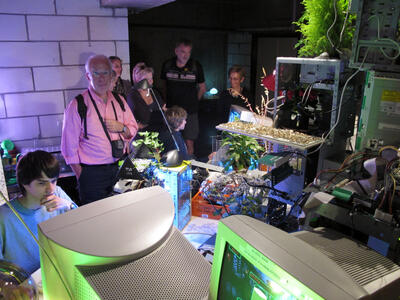
To achieve fast results, the group was split up in smaller working groups, usually consisting of people that joined the workshop together. Each working group then explored their own idea about connecting computer electronics and biological life on a compact scale. This approach contrasted with the longer Biomodd projects where the whole team worked around a much larger central structure.
The participants in the Biomodd Workshop in Sint-Niklaas became autonomous very quickly. Each working group focused on their own creation without a continuous need for guidance from my part. The skill to connect computer electronics was acquired very rapidly, and troubleshooting occurred largely through personal experimentation and peer feedback. 'Liquid War', the open source game that was used throughout the workshop and exhibition, was selected by the participants themselves. It was a game I previously had no knowledge about, with specifications perfectly suited for some of the older hardware we were using. The game environment – essentially maze structures used as battle arenas – was immediately modified to personal taste. In a witty and ironic gesture, the logo of one of the former Biomodd versions was transformed into one of the most popular virtual battlegrounds (or so-called 'maps'). I only made one request: no (cliché) first-person shooting. And 'Liquid War' is exactly that: a top-down 2D world in which each player represents a dynamic 'liquid' trying to overtake his/her opponents by enclosure and osmosis.
Apart from the explicit collaboration it was also apparent that individual participants started carving their own niche throughout the workshop (without loosing sense for the overall project): Thomas took care of all Linux/Ubuntu aspects; Jorrit became a enthusiastic game modder; Pablo, Wim and Pieter specialized in water cooling; Mathias took care of outreach and sponsorship. With productivity and troubleshooting becoming way more efficient, this automatic specialization greatly benefited the workshop.
During this workshop there were different interconnected levels of witnessing and collaboration at work. My father and his partner contributed to the event in their very own way. They own a thrift store in Sint-Niklaas, and borrowed a whole range of materials such as glass ware and a vertical artificial aquarium. These materials became an integral part of the final setup as it was displayed during the Coup de Ville arts festival. The municipal library where the workshop took place was also very supportive throughout the whole project, including the exhibition. Apart from providing us with adequate space and infrastructure, we received full access to their surplus storage. This turned out to become a treasure for the workshop with all types of structural elements that defined the final installation. The workshop was also an opportunity for me to share my past experiences abroad – the Biomodd projects in Ohio and the Philippines – with my own hometown. Apart from a relatively small photo exhibition about 15 years ago, I had never actually shown any of my cross-cultural or bio art projects in Sint-Niklaas. Sharing the workshop experience, the resulting installation, and the broader context of Biomodd allowed my hometown community to get a better grasp of my art. This happened mainly through impromptu talks and explanations by myself while doing maintenance work in the installation. Eisa had been part of the Philippine Biomodd project and as such could help evaluate the success of the new workshop format. As such, she has been instrumental in giving feedback for this particular contribution for Witnessed Presence. The final art installation, which was essentially a hybrid computer network running a multiplayer game, proved the most popular art work of Coup de Ville for the young (high school) generation. Both the concept and aesthetics seemed to readily appeal. The fact that visitors could actually engage with the art work by joining the multiplayer game environment most probably contributed to the work’s success. People felt like they could actually become part of the installation, even if it was only for a short time.
Embedding multiplayer gaming in Biomodd is a very deliberate choice and one of the art work’s core characteristics. It not only virtually and physically engages the visitor with the installation, it also engenders a very specific type of engagement with other visitors. Visitors are turned into 'players' in a shared virtual environment. Through this, visitors immediately become connected in a temporary ad hoc community in which communication and interaction become crucial. In contrast with popular belief, multiplayer gaming is not an introvert activity – participants usually start shouting instructions, warnings, disappointments and congratulations to each other. In Biomodd this becomes a performance – and an invite – for the onlooking visitors. An art work within an art work.
Witnessing motivation

Both my own witnessing and the witnessing by peer participants seemed to have a clear impact on the productivity and motivation of the team. As outlined above, the group was highly autonomous. However, guiding and encouragement remained essential to keep the workshop moving forward. This happened both through individual feedback and group discussions.
Both my own witnessing and the witnessing by peer participants seemed to have a clear impact on the productivity and motivation of the team. As outlined above, the group was highly autonomous. However, guiding and encouragement remained essential to keep the workshop moving forward. This happened both through individual feedback and group discussions.
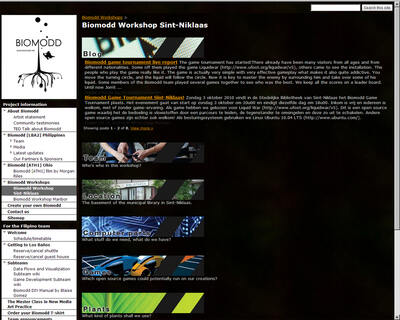
The role of encouragement became very apparent when I was out of the space for one hour or more, looking for materials needed in the workshop. When I came back, the creative atmosphere had often changed. Some people had halted their progress, some were casually involved in conversation, some were surfing the Internet. Generally there was less of a sense of shared purpose. As soon as I started interacting again – distributing the newly found materials and discussing creative directions – the group got focused again. Although most smaller workgroups were working on their own, participants were well aware of the others’ progress and accomplishments. This engendered a healthy sense of competition. Being surrounded by evolving – and often surprising – contraptions stimulated people not to stay behind and push their own boundaries. Of course there was also support between the different workgroups. Individual participants easily helped out other groups with issues they were more knowledgeable about.
Generally the whole team showed a high level of dedication. Several things were explored that hadn’t been done before in the Ohio and Philippine Biomodd projects. We took the chance of trying out an open installation setup instead of working on one centralized monumental structure. This proved to be a good choice and worked out well for the final display during Coup de Ville. New open source games were researched leaving behind the games that were used in Biomodd before. And some of the assembled computer units were really innovative, both in their functionality and sculptural aesthetics. Pieter for example hacked a plastic doll, installed computer hardware inside, and connected the computer’s fans via tubing to a glass biosphere with sprouting seeds. A separate tubing system inside the biosphere was attached to a large syringe which was used to provide water to the seedlings.
Even before the workshop started, Mathias contacted me to help out with preparations. He started looking for additional local participants, used materials, and set up a dedicated section on the community website Biomodd.net. Participants were invited to contribute to this section with observations and reports about their creations. For the opening event, I invited the whole team to be present. By gaming, experimenting and explaining they would become ‘perfomers’ in their own creation. In fact most participants showed up and the installation transformed into an interactive beehive of activity: socially, electronically and biologically. Dressed up and standing close to the entrance, Mathias had taken up the explicit role to welcome visitors which added to the work’s performative quality.
Biomodd is an art project that asks for supervising and maintenance once it’s on display. About half of the workshop participants were actively involved in the exhibition of the installation during Coup de Ville. They took turns supervising the work, and used the opportunity to explain the project to visitors, work on the game, and take care of the plants, seedlings and algae.
Sharing a co-created art work

During the exhibition of the Biomodd installation in Sint-Niklaas, several team members took active care of the art work. It’s relevant to note that although people took pride in their individual creations, they considered the whole setup as one single installation with a strong sense of ownership of the entire art work.
During the exhibition of the Biomodd installation in Sint-Niklaas, several team members took active care of the art work. It’s relevant to note that although people took pride in their individual creations, they considered the whole setup as one single installation with a strong sense of ownership of the entire art work.
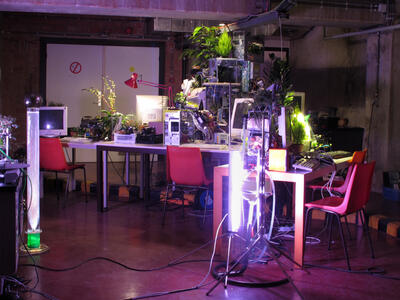
Team members didn't limit maintenance work to their own contributions, but made sure all computer systems were checked, and all plants were taken care of. This particular kind of 'witnessing' connected and integrated the whole installation on a cognitive and emotional level. This was strengthened by the fact that all individual creations had been physically networked in one multiplayer environment. Also, many plants were distributed throughout the installation and were not readily perceived as belonging to any particular computer system.
Simultaneously contributing smaller parts to a larger endeavour and taking 'ownership' (not in commercial or legal sense) resonates perfectly well with the philosophy of open source software. Biomodd consistently makes use of open source software through its operating system (Ubuntu), games, sensor interfacing, etc.
During the exhibition, team members were eager to share the Biomodd installation with festival visitors. They improvised guided tours and sketched the broader context of the project. It was interesting to see how part of my artistic discourse got actually copied and pasted into their own storytelling.
During post-workshop interviews, I asked participants whether and how they communicated the project to their own personal network. Some used an assignment in art class to explain the project to their schoolmates. Others discussed their work with the IT and biology teachers at their school. They felt proud of being part of Biomodd, and generally received good response. Hardcore gamers however, did sometimes dismiss Biomodd because of its lack of high performance hardware and the absence of recent mainstream games. Most of the team members also connected with each other online, and then communicated the workshop through their social networks.
A public 'Biomodd Game Tournament' was organized during the course of the exhibit. The idea was to have a full-day contest for Biomodd team members and public. The rewards were in-kind donations from a local game store. The tournament also functioned as a means for outreach and publicity of the Biomodd project (and the Coup de Ville arts festival). Some of the team members showed great enthousiasm for this event: Jorrit talked extensively about it to his class mates, Thomas was strongly involved with all the technical preparations, and Mathias took care of sponsoring and further outreach. The day of the tournament however, most visitors only joined in for a few gaming sessions. Since they were obviously also interested in the rest of the festival they rarely stayed longer than one hour. Biomodd team members were the only ones joining the tournament for its entire duration – and consequently won all the prizes.
Changes and rhythms in computers, plants and people

When reflecting on the changes and rhythms of computers in Biomodd, one of the first things that comes up is the vastly different time scale in which computers and plants operate. Computers respond in real-time. Plants grow and respond over a matter of hours and days. Connecting both is a creative gesture inquiring into this difference.
When reflecting on the changes and rhythms of computers in Biomodd, one of the first things that comes up is the vastly different time scale in which computers and plants operate. Computers respond in real-time. Plants grow and respond over a matter of hours and days. Connecting both is a creative gesture inquiring into this difference.
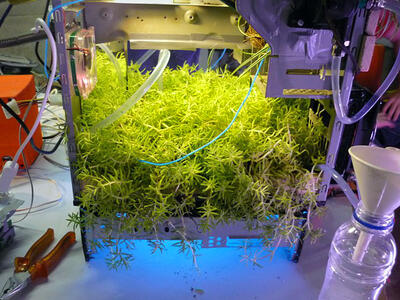
Several team members acknowledged that their perception of computers gradually changed over the course of the workshop. Initially associating a computer with an 'untouchable black box', they came to view it as malleable technology. The same goes for open source operating systems such as Ubuntu. This suddenly became very accessible, and hence a valid alternative for Microsoft Windows or Mac OSX. The ease of connecting different computers into a local area network came as a surprise to some – especially the fact that no more is needed than a small switch box.
The plants were perceived by most participants as the most uncontrollable element. However, notice that none of them had any previous experience with growing plants. If horticulturalists would have been present in the team, we might have heard a different story. The general consensus was that plants simply cannot be dictated, only 'witnessed'. Seedlings generally grew really fast, but the other plants' growth rates seemed to somehow depend on the computer system they were part of. It is difficult to conclude that the actual computer electronics were responsible for this, since every system had its own type of lighting which might have overridden any other effect. Moreover, the connection between electronics and plants was not very clear in all systems. Sometimes plants were simply grown in containers on top of heated components (such as hard drives or power supply units). Most team members were surprised about the high survival rate of the plants, notwithstanding their quite 'unusual' environment. All plants needed to be taken care of manually since watering and nutrient supply were not automated. During the actual workshop more and more plants were gradually added, representing growth on a meta-level. This was mentioned by many team members as a very significant experience. Microscopic algae were an unknown world for most. The fact that the algae culture had been used before in the Philippines (2009) and in Ohio (2007-2008) was a source of fascination.
Apart from changes in computers and plants, there where also obvious changes on a social level. Throughout the workshop the group became much more coherent. The original smaller workgroups consisted of friends who enrolled together, but by the end had started to blend. People ‘grew’ during the workshop, and this was very apparent for a few individuals who started out low-key but gradually found a strong position in the group. Thomas was very quiet in the beginning but turned out to be a gifted Linux wizard. Dries took the role of a sideline spectator in the beginning, but became very active in the follow-up events (exhibition, game tournament). Team members mentioned that learning occurred both through working with computers, plants, and fellow team members. I personally noticed a high level of inventive troubleshooting. In one instance, a motherboard that everyone had given up on, was kick started again using a trashed fan and some duct tape. The pathways in Biomodd can be described using the following image: social meeting (computer use, gaming) gets translated into electronic waste heat which in turn boost biological growth. Hence, the amount of biological proliferation in Biomodd becomes a reflection of the social interaction that the art work generated, both through its creation and its display.
Destroying and seeding art

Each Biomodd project ends with its disassembly. To some this may come across as shocking since so much combined effort went into the creation of the installation. Nevertheless this choice follows the logic of the project. Only through its 'destruction' a subsequent group gets the occasion to start from scratch, and essentially reinvent the project.
Each Biomodd project ends with its disassembly. To some this may come across as shocking since so much combined effort went into the creation of the installation. Nevertheless this choice follows the logic of the project. Only through its 'destruction' a subsequent group gets the occasion to start from scratch, and essentially reinvent the project.
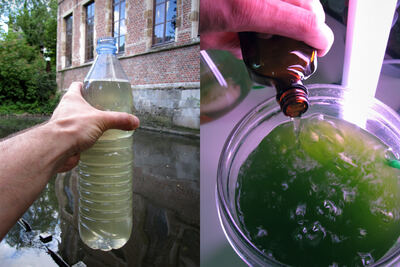
The disassembly process is very carefully conceived: functioning systems and components, as well as the living organisms are donated to team members and project supporters. In this way, these elements obtain a third life in a new context and function as seeds spreading the art work’s ideas. All remaining components are brought to thrift stores or recycling centres. Mathias, Thomas and Jorrit all took their hybrid computer systems back home to continue using. Dries and myself adopted a major part of the plants, and a friend of Mathias adopted the single gold fish. I selected about three boxes of parts and materials to be used in the next Biomodd Workshop in Maribor, Slovenia (November 2010). Some of these components made it even to the subsequent Biomodd Workshop in New Plymouth, New Zealand (January 2011).
The microscopic algae are a recurrent theme/medium in my work and have been used in every single Biomodd iteration so far. I started using green algae as an artistic medium back in 2002 (Biopainting No I). Since 2003, I’ve been retaining a batch of Chlorella algae after each art work in which they were featured. At the start of a new art project, I simply culture this batch up to the needed volume. The algae become an immortal artistic medium like this and a living record of previous experiences. Witnesses of the past and agents for the future. The culture that I used in the Biomodd Workshop in Sint-Niklaas had been growing throughout several art projects in Belgium and both Biomodd projects in Ohio and the Philippines. It’s important to note that wherever you culture Chlorella, it mixes with the local variant of the species. Airborne spores tumble into the water and develop into fully grown cells. After the Biomodd Workshop in Sint-Niklaas, part of the new culture was taken to Slovenia and New Zealand. Currently I have a 'Belgo-American-Filipino-Slovenian-New Zealand' culture in stock in my studio. A multicultural mix ready to mingle with algae from other locations.
Biomodd is a project of constant rebirth. Firstly by its very own nature: giving the same set of core ideas a new shape depending on its location and contributors. But also because of the continuous revival and use of the ongoing algae culture. In the case of the Biomodd Workshop in Sint-Niklaas, we can also talk about a sort of personal ‘rebirth’ in my own hometown acquiring a new – or rather updated – identity in my local community.
Biomodd is explicitly intended as social sculpture, and functions as meeting platform for dialogue and experimentation. The work reaches way beyond its physical and temporal boundaries, influencing people’s perception of the dynamic relationship between nature and technology. Even after closure of an individual Biomodd iteration, the work keeps on living in different pockets of that location – in peoples homes, in local fields and gardens. And since Biomodd is an open source art work, people can freely reproduce, copy and even subvert the project – thus giving it a life beyond my own control.

 Angelo Vermeulen
Angelo Vermeulen
![Blue Shift [LOG. 1], 2005 (with Prof. Luc De Meester). CAD designs of the core components of the installation developed in collaboration with Philips. Images: Lieve Verboven. Blue Shift [LOG. 1], 2005 (with Prof. Luc De Meester). CAD designs of the core components of the installation developed in collaboration with Philips. Images: Lieve Verboven.](http://nev01.test.mediamatic.nl/image/781/4614-400-315.jpg)
![Blue Shift [LOG. 1], 2005 (with Prof. Luc De Meester). All living 'agents' in the system were monitored through CCTV. This monitor filmed the spectators. Blue Shift [LOG. 1], 2005 (with Prof. Luc De Meester). All living 'agents' in the system were monitored through CCTV. This monitor filmed the spectators.](http://nev01.test.mediamatic.nl/image/499/4615-400-300.jpg)




![Blue Shift [LOG. 1], 2005 (with Prof. Luc De Meester). Blue Shift [LOG. 1], 2005 (with Prof. Luc De Meester).](http://nev01.test.mediamatic.nl/image/975/4618-300-400.jpg)

